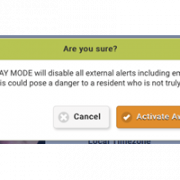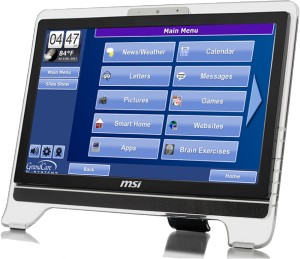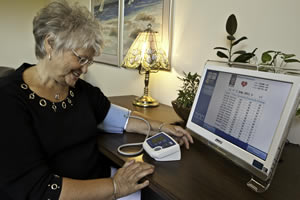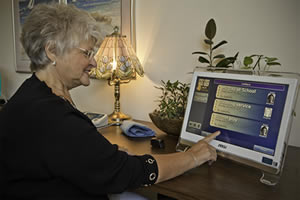We wanted to share the recent article by the Minneapolis Star Tribune on how enabling technologies are helping individuals to live independently, safely and happily at home.
GrandCare could not agree more with Andy Carle’s point of view on the acceptance of technology. When technology makes the quality of life better, it is accepted. When it makes life confusing and difficult, it is not. These seniors that we are discussing are the same folks that went from walking to flying and first put a man on the moon. They are not tech-phobic. We simply need to make the interface and user experience pain free and helpful. At GrandCare, that has been a vision since day one. How can we bridge the generations and connect grandchildren and great grandchildren with their senior family members? How can we find a middle ground when both generations prefer different methods of communication?
Note: As a clarification in the Star Tribune article, the GrandCare System is not an emergency response system. Instead, GrandCare relies on a series of activity and telehealth devices to provide an overview of information on a loved one. The caregivers can set parameters to receive specified alert (unusual activity, doesn’t get out of bed, didn’t access medications, etc.). Designated caregivers can also log in to GrandCare’s web portal to add reminders, medication schedules and even video chat directly to the loved one through a simple and intuitive touchscreen appliance in the loved one’s home. Thanks again for shedding light on this emerging and innovative industry.
The new retirement: Technology
- Article by: PAUL DUNCAN , Star Tribune
- Updated: August 7, 2013 – 9:48 AM
It’s such a cliché: grandpa fiddling with the buttons on the cellphone he barely knows how to use, grandma struggling to remember how to switch the computer on. But is it true that older people don’t like technology and don’t use it?
The reality, says expert Andrew Carle, is completely different from the perception. Carle, director of the Program in Senior Housing Administration at George Mason University and a consultant on aging issues, coined the term “Nana Technology” for innovations that not only help our aging population, but actually can save their lives.
Carle was in Minnesota in June to give a talk to Aging Services of Minnesota in Brooklyn Center on “Nana Technology: Is There A Robot In Your Future?” This is a summary of his presentation:
Why technology is important
In two words: Global aging, says Carle. The first of 78 million baby boomers turned 65 on January 1, 2011, and the population aged 85 and older is expected to more than triple from 5.7 million in 2010 to 19 million in 2050. And it’s not an American phenomenon; on the list of countries with the highest percentage of people over 60, the U.S. comes 43rd. The outcome, says Carle, is that global aging will affect us long before global warming. “Individuals who in 1968 thought they would change the world,” Carle says, “by 2028 actually will.” So how will we take care of all these seniors? The answer is: Technology…
Carle highlights these useful and potentially life-saving technologies for seniors…

GrandCare Systems (grandcare.com): An integrated system that uses sensors around the home to monitor health and wellness, and establishes a baseline of normal activities. Reports emergencies, and allows communication with the senior via an open TV channel or available touch screen unit
…
To read the full article: http://www.startribune.com/lifestyle/goodlife/218580541.html








 “PREDICTION – mHEALTH REVIVES MONITORING: The stationary nature of in-home activity and telehealth monitoring will give way to a disconnect-and-go tablet world that can be docked at home and plays nicely with a cell/smart cellular model. For those walking the floors at CES, you will see tablet apps of every type flowering hither and yon – perhaps you’ll see them tether to a phone. RIM, the anti-marketer, produced an early version of this with the Playbook-BlackBerry tethering. Why not a few tablet apps for seniors (in addition to health and activity monitoring) that sync up with a phone-like device? It may be like trying to cram a large box into a flat rectangle, to start at the hardware end — look at Care Innovations Guide, for example. Why not a partnership between a fitness device vendor (like Fitbit or Philips DirectLife) and a remote monitoring vendor like BeClose or Healthsense? And software-only products like Independa and GrandCare may well benefit from both platform flexibility and a new interest in combining activity sensors and health monitoring.”
“PREDICTION – mHEALTH REVIVES MONITORING: The stationary nature of in-home activity and telehealth monitoring will give way to a disconnect-and-go tablet world that can be docked at home and plays nicely with a cell/smart cellular model. For those walking the floors at CES, you will see tablet apps of every type flowering hither and yon – perhaps you’ll see them tether to a phone. RIM, the anti-marketer, produced an early version of this with the Playbook-BlackBerry tethering. Why not a few tablet apps for seniors (in addition to health and activity monitoring) that sync up with a phone-like device? It may be like trying to cram a large box into a flat rectangle, to start at the hardware end — look at Care Innovations Guide, for example. Why not a partnership between a fitness device vendor (like Fitbit or Philips DirectLife) and a remote monitoring vendor like BeClose or Healthsense? And software-only products like Independa and GrandCare may well benefit from both platform flexibility and a new interest in combining activity sensors and health monitoring.”
 The GrandCare system was the first system to combine socialization, activities of daily living (ADLs) and telehealth monitoring, which together provide peace of mind for family members living close by or long distance. With “wireless” Bluetooth, X10 and ZWave sensors throughout the home, family and caregivers can monitor the senior’s health and home. No computer skills are needed to operate the easy to use senior home care solution that features an interactive touch screen. Designated caregivers and family can log into the GrandCare website and access sensor graphs, vitals and set up parameters/rules to receive alerts if specific events occur such as medications are not taken, a door is opened at odd times, a refrigerator is not accessed at meal time or an individual did not get out of bed.
The GrandCare system was the first system to combine socialization, activities of daily living (ADLs) and telehealth monitoring, which together provide peace of mind for family members living close by or long distance. With “wireless” Bluetooth, X10 and ZWave sensors throughout the home, family and caregivers can monitor the senior’s health and home. No computer skills are needed to operate the easy to use senior home care solution that features an interactive touch screen. Designated caregivers and family can log into the GrandCare website and access sensor graphs, vitals and set up parameters/rules to receive alerts if specific events occur such as medications are not taken, a door is opened at odd times, a refrigerator is not accessed at meal time or an individual did not get out of bed.





